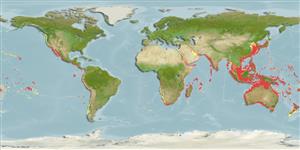Common names from other countries
Environment: milieu / climate zone / depth range / distribution range
экология
ассоциированный с рифами; пределы глубины 0 - 222 m (Ref. 106682). Tropical
Southeast Atlantic and entire tropical Indo-Pacific from Red Sea and South Africa to the Hawaiian Islands.
Length at first maturity / Size / Вес / Возраст
Maturity: Lm ? range ? - ? cm Max length : 12.0 cm WD самец/пол неопределен; (Ref. 800)
The five arms have blunt and tapered ends that curve slightly upwards. Both oral and aboral sides are flattened, with the aboral disc being slightly convex. Body color varies from greenish-blue, to brownish-gray and dark reddish-brown. This species is characterized by its distinctive laterally projecting rows of spines on the supero-marginal plate.
Buried in the sand during daytime and crawls on the sand to search for food at night. Feeds primarily on bivalves and gastropods and other small invertebrates buried in the sand (Ref. 800).
Life cycle and mating behavior
половая зрелость | размножение | нерест | икра | Fecundity | личинки
Members of the class Asteroidea exhibit both asexual (regeneration and clonal) and sexual (gonochoric) means of reproduction. Life cycle: Embryos hatch into planktonic larvae and later metamorphose into pentamorous juveniles which develop into young sea stars with stubby arms.
Основная ссылка
ссылки | координатор | соавторы
Schoppe, S. 2000. (Ref. 800)
Статус Красного Списка МСОП (Ref. 130435)
Статус СИТЕС (Ref. 108899)
Not Evaluated
Not Evaluated
Угроза для людей
Harmless
Использование человеком
| FishSource |
инструменты
дополнительная информация
Возраст/РазмерыростЗависимость между длиной и массой телаЗависимость между длинамиморфологияличинкичисленность
ресурсы в Интернет
Estimates based on models
Preferred temperature
(Ref.
115969): 15.3 - 29, mean 27.4 (based on 2738 cells).
Уязвимость
Low vulnerability (10 of 100).
Категория цены
Unknown.
